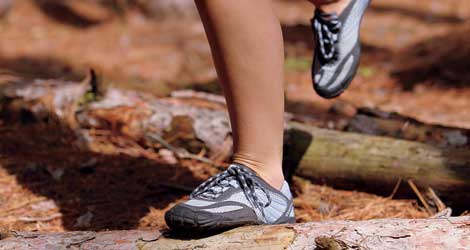The New Era of Running Shoes
The entry of barefoot or minimalist styles into the market started turning heads in 2006.

At the 2010 Oceanside Ironman 70.3 expo in Southern California, a crowd had gathered inside the Newton running shoe booth. The attraction appeared to be the bright colored footwear on display racks accompanied by a rolling video discussing proper running technique and recent laboratory results showing the benefits of the new running shoe.
By all accounts we’ve entered a new age of shoes, with dozens of new names entering the market. As recently as five years ago, major brands such as Nike, Brooks, Asics and Saucony dominated the market and race scene offering footwear with stability, support and comfort. In addition to Newton, outdoor shoe experts Merrell launched a barefoot shoe in 2011 and Finland’s Karhu, a neutral forward motion shoe, reports a three-digit increase in revenue over the past two years.
“We had become rather stagnant in the footwear industry. People started evaluating what works,” says Jay Duke, president of Karhu North America. “Nobody hit it first but Nike created a stir in the market with a barefoot feel shoe.”
Sorting Out the Styles
The entry of barefoot or minimalist styles into the market started turning heads in 2006, when Nike introduced the Free Run, a barefoot feel, with shoe-like benefits drawing attention to a new style of running in a natural form. A massive marketing effort including an endorsement by Oprah Winfrey naming the shoe one of her favorite things fueled the increasing interest. The Free Run, along with other minimalist shoes such as Vibram’s FiveFingers, differ from traditional running shoes by having a thinner, more flexible sole with no heel cushioning. With the feet positioned closer to the ground, the feeling is similar to moving barefoot.
“When I was a kid, I remember the coach saying take off your shoes and run on the grass,” says Christian Triquet, president of Outdoor Group Canada. “These days we say, what if we were to take away all these things (cushioning, stability) and re-stimulate our feet and ankles.”
In contrast, neutral shoes such as Karhu, which have been on the market for decades, promote a forward motion to transfer energy into the forefoot by eliminating the extras such as medial positioning, which controls foot pronation. Most neutral shoes do have some cushioning and, while the mid-sole thickness is similar to motion control shoe, the material is softer.
The Right Shoe for You
Choosing the best fitting shoe for optimal performance depends on several factors. While the new styles may be the rage, traditional stability or motion control footwear may still be the best choice for some athletes.
Studies show that 80 percent of runners are heel strikers. Faster, more experienced runners may have an easier time adjusting to a mid/forward foot strike shoes because as you run faster, the foot naturally goes to a more forward, toe running pattern. Slower, or less experienced athletes, may want to consider a traditional heel strike shoe until the body and muscles have built a base and speed to benefit from a mid to forefoot strike.
According to podiatrist, Kevin Kirby, an adjunct professor at the California School of Podiatric Medicine, body weight is also a good way to help determine what options you actually need, or don’t, in a running shoe.
A neutral style may be a good choice for a lighter female less than 120 pounds who will not benefit from a heavy shoe with motion control and runner’s with a more stable arch and a foot which does not pronate. A heavier person may respond better to a cushioned and firmer shoe. A stronger, more stable foot would also be better fit for the barefoot shoe.
“I tell my patients, regardless of any marketing claims, be wary of new marketing. Many claims aren’t scientific,” says Kirby. “Avoid the common mistake of paying too much attention to friends and marketing and not enough attention to what type of running you are doing.”
Think Slow Transition
Changing from your traditional shoe to one with a lower, or negative, heel height (which promotes a forward motion) should always be a carefully planned process. You need to adapt to changes in a shoe to avoid severe muscle aches and pain and injury to the ankles and toes. Most companies offer detailed webcasts, videos and presentations regarding use. Whether trying a pair of Newton’s with a negative heel, or a barefoot style such as the Vibram’s FiveFingers runner, or changing to a more forward motion neutral shoe such as Karhu, the body will take time to get accustomed to a new position.
“The body takes months to adapt to a new running style,” says Kirby. “If you think the style is right, only run a third of your miles in them and switch every few days. You’ll be able to decide if the shoe is hurting or helping.”
With so many new choices now available, research, testing and a careful transition to a new shoe can avoid injuries and give you the best chance for a better performance. Just like changing your aerobars, bike seat or pedals, be patient and let your body properly adjust to the new position.
